Annapurna Base Camp Trek
In the realm of mountain adventures, the Annapurna Base Camp Trek stands as a timeless classic, beckoning intrepid explorers to discover its secrets.
As trekkers traverse through a tapestry of landscapes, a sense of anticipation builds with each step towards the majestic Annapurna range.
But what awaits at the heart of this journey goes beyond mere physical challenge; it’s a rendezvous with nature’s grandeur that leaves an indelible mark on all who dare to embark.
Key Points
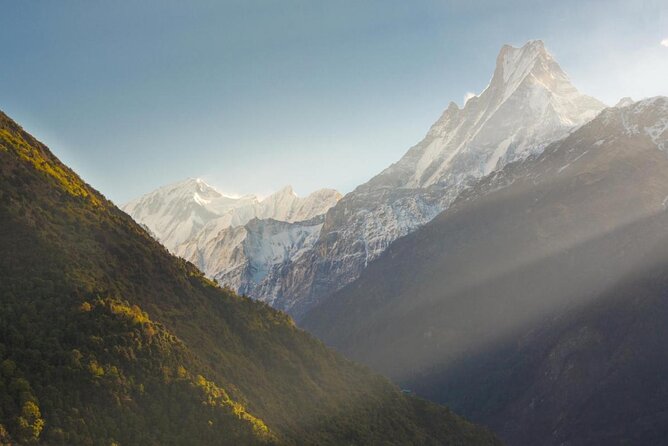
- Diverse landscapes and cultural experiences await in the Himalayas.
- Optimal trekking seasons are March to May and September to November.
- Obtain necessary permits like ACAP and TIMS for environmental conservation.
- Essential packing includes sturdy gear like waterproof clothing and trekking poles.
Overview of Annapurna Base Camp Trek
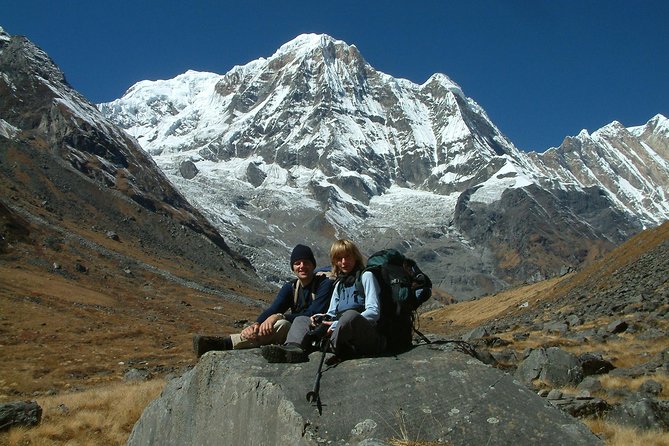
Nestled in the heart of the majestic Himalayas, the Annapurna Base Camp Trek offers adventurers a breathtaking journey through diverse landscapes and cultural experiences.
The trek difficulty levels vary from moderate to challenging, catering to a wide range of hikers. Trekkers can expect to navigate through lush forests, terraced fields, and rugged terrain as they make their way to the base camp, providing a mix of challenges and rewards.
Along the way, hikers will have the opportunity to enjoy the rich cultural experiences of the local communities, interacting with friendly villagers, experiencing traditional Nepalese hospitality, and witnessing unique customs and traditions that have been preserved for generations.
Best Time to Visit
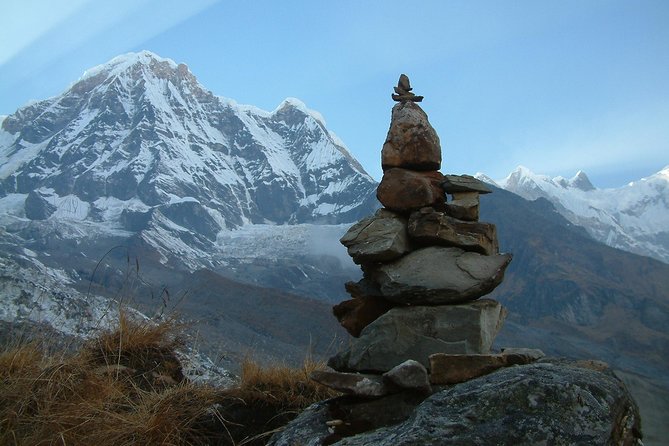
For those planning to embark on the Annapurna Base Camp Trek, understanding the best time to visit is key to ensuring a memorable and successful journey through the Himalayan landscapes. The optimal periods to undertake this trek are during the spring months of March to May and the autumn months of September to November.
During spring, the weather conditions are generally stable with clear skies and blooming rhododendrons, making for a picturesque experience. Autumn offers crisp, cool days and excellent visibility of the stunning mountain panoramas. These seasons also coincide with moderate trekking difficulty, as the trails are less slippery and more manageable compared to the monsoon season.
Choosing the right time to visit ensures an enjoyable trekking experience with favorable weather conditions and stunning views.
Trek Itinerary and Highlights
Embark on the Annapurna Base Camp Trek to learn about the breathtaking beauty of the Himalayan landscapes and discover a trekking experience like no other. The trek itinerary typically spans around 7-12 days, covering diverse terrains and picturesque villages.
Along the journey, trekkers encounter various challenges like steep ascents, rugged paths, and high altitudes, offering a thrilling adventure for outdoor enthusiasts. Amidst the trekking challenges, one can also indulge in the delightful local cuisine, sampling traditional Nepalese dishes like dal bhat (rice and lentils), momos (dumplings), and thukpa (noodle soup).
These local flavors add a cultural touch to the trekking experience, providing a taste of authentic Himalayan gastronomy amidst the stunning natural surroundings.
Required Permits and Fees
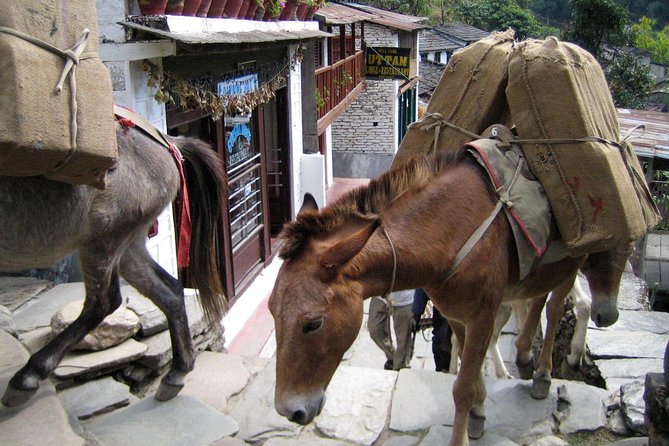
As trekkers progress through the Annapurna Base Camp journey, they must obtain the necessary permits and pay the required fees to ensure compliance with local regulations and support conservation efforts in the region.
-
Permit regulations:
-
Trekkers need to acquire the Annapurna Conservation Area Permit (ACAP) and the Trekkers’ Information Management System (TIMS) card before starting the trek.
-
These permits help regulate the number of visitors and contribute to the preservation of the natural environment.
-
Entrance fees:
-
The current entrance fee for the Annapurna Sanctuary area is approximately NPR 3,000 for foreign trekkers.
-
Local regulations require trekkers to carry these permits at all times during the trek to present them when requested by authorities.
Accommodation Options on the Trek
Accommodation options along the Annapurna Base Camp trek cater to various preferences and budgets, ranging from teahouses to lodges nestled amidst the picturesque mountain landscapes.
Teahouses are a popular choice among trekkers, offering a cozy atmosphere and a chance to connect with fellow hikers. These basic accommodations provide meals and a place to rest after a long day of trekking.
On the other hand, lodges provide a bit more comfort with private rooms and attached bathrooms, ideal for those looking for a more relaxed stay. Accommodation reviews praise the hospitality of the hosts, the stunning views from the rooms, and the hearty meals served.
Trekkers can choose from a variety of lodging choices along the trail to suit their preferences.
Packing List Essentials
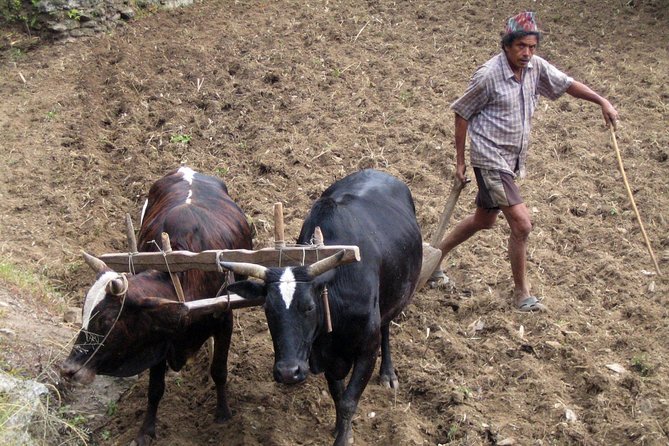
When preparing for the Annapurna Base Camp trek, packing essential items such as sturdy hiking boots and high-quality waterproof clothing is crucial for a comfortable and safe journey. Along with these basics, there are several other essential gear items to consider bringing:
-
Sleeping bag rated for cold temperatures: Nights at higher altitudes can be chilly, so a proper sleeping bag is essential for a good night’s rest.
-
Trekking poles: These can provide stability and support on challenging terrain, reducing strain on your legs.
-
Water purification tablets: Ensuring access to clean drinking water throughout the trek is vital for staying hydrated and healthy.
-
High-energy snacks: Having quick and easy food options on hand can help maintain energy levels during long days of hiking.
Tips for a Successful Trek
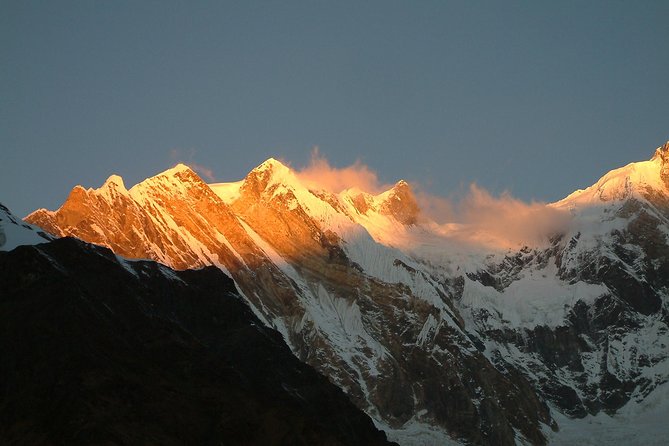
For a successful trek to Annapurna Base Camp, ensuring proper acclimatization by gradually ascending in altitude is crucial to prevent altitude sickness and enjoy the breathtaking mountain views along the way. It’s recommended to spend a few days in villages like Ghorepani to acclimatize before pushing higher.
Essential gear includes a sturdy pair of hiking boots, warm clothing layers, a good quality backpack, trekking poles for stability, a reliable sleeping bag, and a refillable water bottle. Acclimatization tips involve staying hydrated, avoiding alcohol and tobacco, pacing oneself, and listening to the body for signs of altitude sickness.
Following these guidelines won’t only enhance the trekking experience but also contribute to a safe and memorable journey to Annapurna Base Camp.
Common questions
Are There Any Age Restrictions for Participating in the Annapurna Base Camp Trek?
Age requirements for high-altitude treks vary but physical fitness is crucial. Safety precautions include altitude acclimatization to prevent altitude sickness. It’s important to assess one’s health and consult with a doctor before embarking on such adventures.
What Is the Availability of Medical Facilities Along the Trekking Route?
Medical assistance along the trekking route is limited. Altitude sickness is a common concern, and emergency services may be hours away. It’s advisable to carry a basic first aid kit and have a plan for any medical emergencies that may arise.
Is It Necessary to Hire a Guide or Porter for the Trek, or Can It Be Done Independently?
For safety precautions, hiring a guide or porter is recommended, especially for challenging treks. Budget considerations should include the cost of a guide versus potential risks of going independently. Guides provide local expertise, assistance, and enhance the overall experience.
Are There Any Communication Facilities Available During the Trek for Emergencies?
In remote trekking locations, emergency communication is crucial. Satellite phones offer a reliable means of contact in case of unforeseen situations. These devices provide a lifeline for trekkers in need of assistance, ensuring safety during challenging expeditions.
How Is Waste Management Handled Along the Annapurna Base Camp Trek Route?
Proper waste disposal and recycling are crucial for environmental impact and sustainability. Implementing effective waste management systems along trekking routes helps preserve the natural beauty of the area and ensures a cleaner environment for future visitors.
Last Words
Embark on the Annapurna Base Camp Trek for a thrilling adventure through diverse landscapes and stunning mountain views.
With the right permits, accommodations, and packing essentials, trekkers can enjoy the beauty of the Himalayas while challenging their bodies and spirits.
Whether seeking an outdoor thrill or a spiritual connection with nature, this trek offers an unforgettable experience for all who dare to explore its rugged terrain.